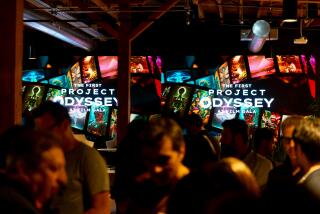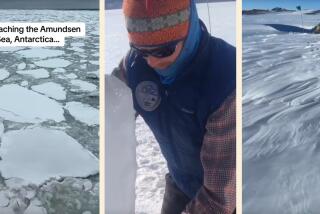As VidCon gets underway, science presenters rule the Web
- Share via
The seventh annual VidCon, which salutes, encourages and markets products to YouTubers and other makers of online video is underway Thursday through Saturday at the Anaheim Convention Center. Originally created by Hank and John Green (“VlogBrothers”), the conference is testament to the energy and variety of Web-based programming — as reflected in this April roundup of online science shows. As usual, the conference is sold out but livestreams may be followed here.
Science!
I do not have a head for it, but I do have love for it. Practically, I profit from it; philosophically, I endorse it.; personally, I enjoy it. Curiosity, inquiry and a willingness to be proved wrong, to bow to the better explanation when it comes along — these are tonics against the inflexible fundamentalism, the epidemic unthinking, that makes the world a shakier place.
And so I have been taking comfort and inspiration from what seems to be a great flowering of science-themed programming, much of it on the Internet, where subjects that mainstream commercial television dubs “not for everyone” may take root and flourish. Apart from PBS, home to “Nova” and “Nature,” and some dedicated (or half-dedicated) cable networks like National Geographic Channel, Science and Discovery, television tends to like its science fictional. And while science fiction is a known gateway to a career in serious science and can be similarly stimulating, the workings of the nonfictional universe are more profoundly exciting and all the more amazing for being, you know, real.
For many, science can seem a world apart — unintelligible, even evil. Tom Swift notwithstanding, the scientists of popular fiction tend to be awkward, eccentric, on the spectrum, troubled, overreaching or insane. Their insights often have disastrous ends — paging Dr. Frankenstein — which, of course, has often been the case with real-world science. (Gunpowder, atom bombs, DDT ... it’s a long and lengthening list.)
It is not a wholly new character, the cool, attractivist scientist: consider Carl Sagan, Brian Cox, Brian Greene, Neil deGrasse. But the new school of science presenters, the Mr. and Ms. Wizards and Science Guys and Girls of the 21st century, children of an age in which nerdiness became kind of sexy, trend younger. If they are less impressively credentialed than their predecessors — who did science, sometimes groundbreaking, before and besides talking about it — the best have a similar gift for communication, for translation, for making complicated ideas comprehensible. (At least while they’re speaking; you may need to revisit the material later.) Some have millions of subscribers, some millions fewer.
But they share what an older person would call a youthful enthusiasm. The material is not just educational or uplifting but exciting in a way native to the platform.
Many include animations; some have songs. They can run from anywhere to a few minutes to a quarter of an hour or longer. They are colorful, fast and funny; the impulse is to take them in fistfuls, like popcorn. But you can’t be mindless — you have to pay attention as idea builds upon idea. Information comes at a clip. It wakes you up.

My doorway into this particular corner of cyberspace was a series called “It’s Okay to Be Smart,” written and hosted by Dr. Joe Hanson and part of the PBS Digital Studios channel. “My mission in life is to tell the world about the awesomeness of ALL THE SCIENCE,” Hanson — one of the hosts of PBS’ multi-platform “Big Blue” special from Monterey Bay last August — has written. Subjects covered on his webcast range from “The Physics of Space Battles” to “The Science of Kissing” to “Why People Don’t Believe in Climate Science.”
Also under the PBS Digital Studios umbrella are “Physics Girl,” hosted by Dianna Cowern (“Yeah, quarks are awesome”); Anna Rothschild’s “Gross Science,” which has included segments on “What’s Living on your Contact Lenses?” and “How Different Diseases Make You Smell”; and “Crash Course” from superstar vloggers Hank and John Green. Elsewhere, Hank hosts “SciShow,” and John is one of three hosts of its spinoff, “SciShow Space.” (There’s a “SciShow Kids” too.)
The new science presenters are as likely to be women as men. Sometime Green brothers’ associate Emily Graslie hosts “The Brain Scoop,” set around Chicago’s Field Museum of Natural History. “Mathemusician” and artist Vi Hart, whose hand-drawn clips now reside at the online lecture hub Khan Academy, is perhaps the most personal, philosophical and poetic of the crowd.

There is “Veritasium,” presented by Australian Canadian Derek Muller, who hosted last year’s PBS documentary “Uranium: Twisting the Dragon’s Tail” and who notes that “sometimes the simplest questions have the most amazing answers.” Another Australian, the BBC-trained Brady Haran, makes interview-based short science films that variously appear on websites and YouTube channels “Numberphile,” “Computerphile” and “Periodic Table of Videos.”
And there is “Because Science with Kyle Hill,” from the Nerdist network, in which the Andrew W.K. of science videos applies physics and chemistry to questions like “Why Kylo Ren’s Lightsaber Works (“I haven’t seen this much debate around a piece of ‘Star Wars’ tech since Han Solo said ‘parsec’ instead of literally any measurement of time”) and “Why Doesn’t Iron Man’s Suit Kill Him?”
One of the YouTube stars who interviewed President Obama in January, Alabamian rocket engineer Destin Sandlin of “Smarter Every Day,” begins his experimental clips saying, “Hey, it’s me Destin” and ends with a citation from the Bible. Religion is not for every believer incompatible with science, of course, nor the world any less wonderful to them for being governed by discoverable, natural laws and not unknowable magical fiat.

Canadians Mitchell Moffit and Gregory Brown run the puckish “AsapSCIENCE.” Their video “What Color Is This Dress? (Solved with Science),” taking off from a 2015 viral meme, has had more than 20 million views. It’s not always a pretty picture they paint with their white-board animations: “What Happens When You Die?” is unblinking about the whole degenerative process. Heaven doesn’t come into it, but it does end with a flower.
They like to collaborate too, these young communicators of science, to cross over, to drop by one another’s videos. Whether they’re scientists themselves or not, they’re good teachers, voices for logic, for intuition and experiment. Who’s to say that a more reasonable future doesn’t start here? In looking squarely at and deeply into things, they respect the actuality that enfolds us all. Hanson may point out that we yearly produce a mass of plastic equal to the combined weight of every person on the planet, but he also has this to say: “Congratulations! You’re alive, a conscious being understanding itself, intricate chemical machinery that evolves and changes over time. That’s a big deal.” And as bracing to me as a cold glass of H2O.
ALSO:
VidCon, the annual video star convention, has gotten so big it’s expanding globally
VidCon moderator and YouTube star Mike Rugnetta on the internet of ideas
Facebook a bigger player at this year’s VidCon
More to Read
The complete guide to home viewing
Get Screen Gab for everything about the TV shows and streaming movies everyone’s talking about.
You may occasionally receive promotional content from the Los Angeles Times.







